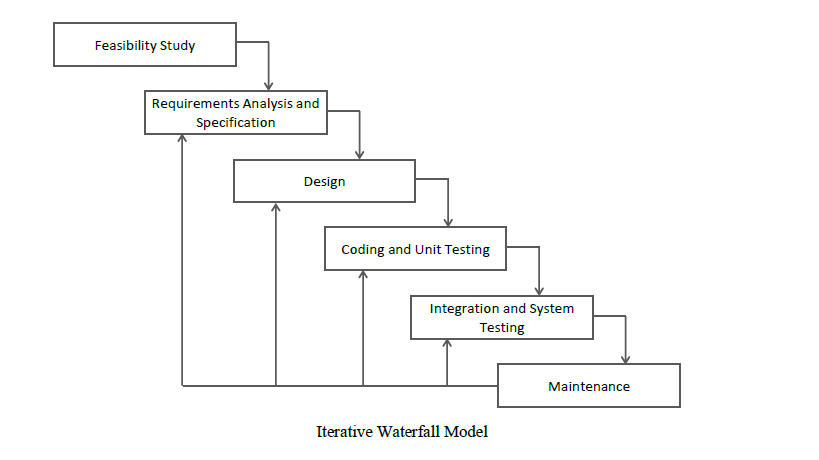The Iterative Model is a popular and effective approach used in the software engineering field to develop high-quality software products. This model is based on the iterative and incremental approach, where the development process is divided into multiple small iterations, each focused on specific tasks, and is executed in a sequential manner. During each iteration, the software is developed, tested, and evaluated, and feedback is taken to make necessary changes and improvements. The iterative model has become increasingly popular due to its flexibility, adaptability, and ability to accommodate changes during the development process.
This article will provide a comprehensive overview of the iterative model in software engineering, highlighting its key features, advantages, and limitations.
The iterative waterfall model’s feedback pathways are depicted in the diagram below.

Phases in Iterative Waterfall Model
- Requirement Gathering & Analysis: The first phase of the iterative model is the requirement gathering and analysis phase, where the software team gathers and analyzes requirements from the customers. During this phase, the requirements are checked by an analyst to ensure that they can be fulfilled within the budget. If any requirements are found to be unfeasible, the analyst works with the customers to revise and refine them until they are feasible. Once the requirements are finalized, the software team moves on to the next phase.
- Design: In the design phase, the software team designs the software using various diagrams such as Data Flow diagram, activity diagram, class diagram, state transition diagram, etc. These diagrams help in visualizing the system and provide a clear understanding of the software’s functionality and structure.
Implementation: The implementation phase involves writing the requirements in a coding language and transforming them into computer programs, which are known as software. During this phase, the software team follows coding standards and best practices to ensure the quality of the code. - Testing: After completing the coding phase, the software testing phase starts using various test methods. The most common test methods used are white box, black box, and grey box test methods. Testing is essential to ensure that the software meets the specified requirements and functions as intended.
- Integration and System Testing: Integration and System Testing are critical phases of the Iterative Model in software engineering. In the Integration phase, different software modules are combined to form a single system and then tested to make sure they work together correctly. System Testing, on the other hand, tests the entire software system to make sure it meets the user’s needs, works well, and is easy to use. Both of these phases are repeated many times throughout the development process to catch problems early and fix them quickly. This helps ensure that the software is high-quality, delivered on time, and meets the user’s requirements.
- Maintenance: In the maintenance phase, after the deployment of the software in the working environment, bugs or errors may be detected, or new updates may be required. Maintenance involves debugging and adding new features to the software to ensure its smooth functioning. The maintenance phase ensures that the software continues to meet the changing needs of the users.
When SDLC Iterative Model is Used?
- The Iterative Model is useful when requirements are clearly defined and easy to understand.
- The model allows for flexibility and adjustment based on feedback and changing needs, making it particularly useful when the requirements are not entirely clear or the project is complex.
- It is also a good choice for large software applications that can be divided into smaller, more manageable parts.
Ongoing testing and quality assurance throughout the development cycle is an important part of the Iterative Model, helping to catch and address issues early on. - The Iterative Model is a good fit when there is a requirement for future changes in the software, allowing the development team to build a core system that can be iteratively enhanced.
- The development team can work iteratively, testing and improving the software in small increments, which can help to mitigate risk and prevent problems down the line.
Advantages of Iterative Waterfall Model
- The model allows for parallel development planning, meaning that different parts of the project can be worked on simultaneously, increasing efficiency and speed.
- The Iterative Model is easily adaptable to changing project needs, which can help to ensure that the final product meets the requirements of the user.
- Testing and debugging during smaller iterations is easy, helping to catch and resolve issues early on in the development process.
- The Iterative Model encourages ongoing feedback and communication between the development team and the user, which helps to ensure that the final product meets the needs of the user and is of high quality.
- Limited time is spent on documentation, freeing up more time for designing and developing the software.
Disadvantages of Iterative Waterfall Model in SDLC
- The Iterative Model may not be suitable for smaller projects, as the overhead involved in the iterative process may outweigh the benefits.
- More resources, including time and money, may be required to implement the Iterative Model due to the repeated cycles of development, testing, and feedback.
- Changes to requirements can cause the project to go over budget, as the iterative process may require additional time and resources to accommodate changes.
- The iterative process may not work well for projects with strict or inflexible requirements, as constant changes and refinements may not be feasible or practical.
- Communication between the development team and the user is critical to the success of the iterative process. If this communication is lacking, it can lead to misunderstandings, wasted effort, and delays in the project timeline.
Hope you guys have been able to gather complete information about the Iterative Model in Software Engineering. For more details about other models in Software Engineering kindly keep browsing our tutorials.freshersnow.com in your free time.
